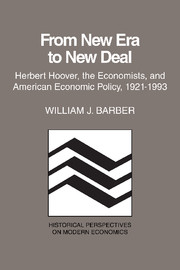Book contents
- Frontmatter
- Contents
- Preface
- Prologue: The vision of a new era in the 1920s
- 1 The ingredients of a model of a new economics
- 2 Challenges to the new economics of the 1920s
- 3 The new economics at center stage in 1929
- 4 Activating the stabilization model in late 1929 and 1930
- 5 Preliminary readings of the results of the stabilization strategy
- 6 The unraveling of the first official model in 1931
- 7 Shifting course in late 1931 and early 1932
- 8 Renewing the offensive in February and March 1932
- 9 The economists and their views on policy for 1932
- 10 Official model II as shaped in May 1932 and the aftermath
- Epilogue: Transition to the New Deal – continuities and discontinuities
- Notes
- Selected bibliography
- Index
8 - Renewing the offensive in February and March 1932
Published online by Cambridge University Press: 19 October 2009
- Frontmatter
- Contents
- Preface
- Prologue: The vision of a new era in the 1920s
- 1 The ingredients of a model of a new economics
- 2 Challenges to the new economics of the 1920s
- 3 The new economics at center stage in 1929
- 4 Activating the stabilization model in late 1929 and 1930
- 5 Preliminary readings of the results of the stabilization strategy
- 6 The unraveling of the first official model in 1931
- 7 Shifting course in late 1931 and early 1932
- 8 Renewing the offensive in February and March 1932
- 9 The economists and their views on policy for 1932
- 10 Official model II as shaped in May 1932 and the aftermath
- Epilogue: Transition to the New Deal – continuities and discontinuities
- Notes
- Selected bibliography
- Index
Summary
Once the Reconstruction Finance Corporation was open for business, Hoover believed that a secure foundation had been placed beneath the nation's financial structure. It was now time for measures to reactivate lending and spending.
But a technical detail required attention before the full potential of a new drive for recovery could be realized. Since his session with New York bankers to form the National Credit Corporation in October 1931, Hoover had pressed, but without success, for revisions in the Federal Reserve Act to widen the definitions of assets eligible for rediscount at the Federal Reserve Banks. Revision in the rules governing the conduct of the central banking system took on fresh urgency in February 1932. The law required that its issues of currency – Federal Reserve notes – be fully collateralized, with at least 40 percent of the backing in the form of gold and the remainder in short-term commercial paper. The Federal Reserve, however, now faced a crisis in living within these rules while, at the same time, carrying out its charge to supply Federal Reserve notes on demand. The number of notes requiring backing had been swollen by the increasing preference of the public to hold cash rather than bank deposits. Meanwhile the ability of the system to find the necessary backing had been reduced. The outstanding volume of commercial paper had been shrunk by the drying-up of business demand for credit during two years of depression.
- Type
- Chapter
- Information
- From New Era to New DealHerbert Hoover, the Economists, and American Economic Policy, 1921–1933, pp. 139 - 145Publisher: Cambridge University PressPrint publication year: 1985

